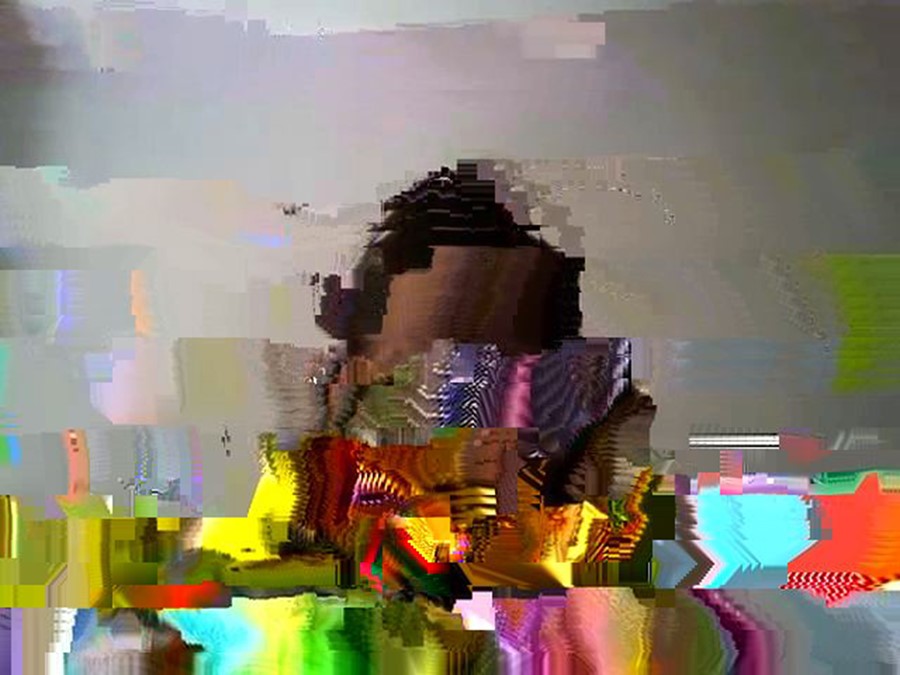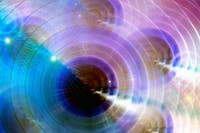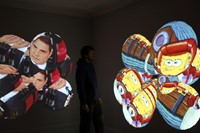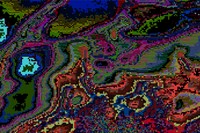Emails, jpegs, gifs, pop-ups, animations, video streams, games – we are all relentlessly overloaded with digital technology. This constant state of flux that infuses into our daily lives, is what we know as the Internet.
Emails, JPEGs, Gifs, pop-ups, animations, video streams, games – we are all relentlessly overloaded with digital technology. This constant state of flux that infuses into our daily lives, is what we know as the internet. The most influential experience and interface to have emerged over the past decade, it is also the source of AnOther Contributing Editor Francesca Gavin’s latest curated exhibition, New Psychedelica. Reinventing old motifs from 1960s psychedelica, a new wave of artists are, through their work, examining and depicting this inundation of information and excess of imagery. Paying a distinct likeness to the perceptual distortion and trippy experience associated with the initial movement, the 15 international artists exhibiting bring together sculptural installations, video works, disintegrating images, code and technology that play with modern altered states. Here, we speak to Gavin about this new psychedlica.
How did you come up with the idea to create this exhibition?
About three years I found myself increasingly coming across artworks and video pieces in particular that were so trippy. Pieces that I wanted to be consumed by and stand in front of until my eyes spun. It made me think of a lot about old pyschedelic references – dream machines, retinal art, even neon rave fractals. I presented a talk about the subject for a Mark Titchner event at the Royal Academy in London in 2009 and originally wanted to create a book on the subject. When I met the director of MU in Eindhoven, she asked me to propose it as an exhibition.
What made you pick these 15 artists in particular?
Many of the artists were obvious choices. Jim Drain's work has often touched on psychedelic references – from knitted mushrooms sculptures to his insane video works with Forcefield and on his own. Paul B Davis, as one of the creators of data moshing and Nintendo art hacking, has always been one of the most innovative people working with computers. Daniel Keller and Nik Kosmas aka AIDS-3D are also obvious names in the world technologically infused artworks. I wanted to show a lot of video work as I felt that screen based experience was so central to the idea behind the exhibition. I wanted the exhibition to reflect the same overwhelming, confusing chaos that the internet and media create inside our psyches. Sitting in front of your computer, stumbling across a video by Jimmy Joe Roche or Yoshi Sodeoka and blowing your mind.
What do you feel about the role the internet and digital technology plays in our lives today?
I think the internet ha been incredibly transformative on how we look and relate to everything. The pop-up poker ads, the Gif porn, the bold, highlighted capitalised columns of advertising, the streaming TV channels, the never-ending flow of image and information, the flash games, the sheer hellish addictive nature of checking your emails. I am on the cusp of the generation before the internet blew up and remember a life when brain washing only happened through the TV screen. Technology doesn’t just play a part in our [Western, capital-driven] lives. It is life.
Were you involved or part of the original psychedelic movement?
I’m way too young! I lived in Woodstock for six years when I was a child. This was decades after the festival but you would still get people turning up, mid life crises and dressed in tie-dye. I’ve always loved the art that emerged from the original psychedelic period. The graphic fluidity, the utopian politics. The first show I ever curated an exhibition was a homage to Mati Klarwein, a visionary psychedelic painter. But my youth was also filled with pixel-heavy computer games, cheap TV, synethetic music, and later rave culture. The work I’m looking at now fuses all of those past pop references.
What are the main similarities between then and the New Psychedelica now?
I think old psychedelica was originally about breaking down social boundaries – the politically powerful possibility of drugs, different modes of living, the formation of new aesthetic. Today that breaking down of boundaries is more hands on – the misuse of technology to break down its structures. Both overwhelm the viewer with colour, light, movement, image, the sensorial side of art.
All of the artists exhibiting are using digital technology as their starting point or medium – do you think this is the future of art?
Not all the artists use digital mediums in their work but all are aware of its presence. Art becomes irrelevant when it doesn’t reflect contemporary society, modern experience, the life of the artist. It amazes me that there isn’t more art about our relationship to technology, and yes I think there will be increasing waves of artists who use the digital. However I think there will also be a love of fetishised art objects, so I wouldn’t proclaim the death of 2D mediums just yet.
New Psychedelica at MU Eindhoven runs from 9 April – 5 June.
Text by Lucia Davies



